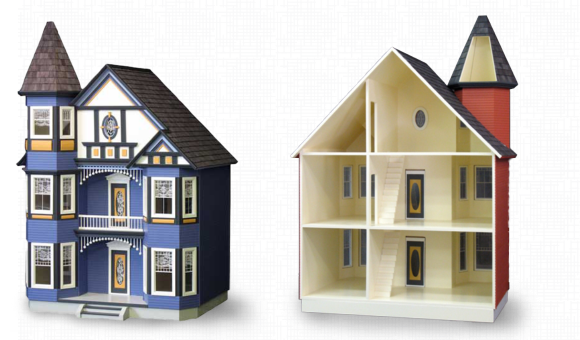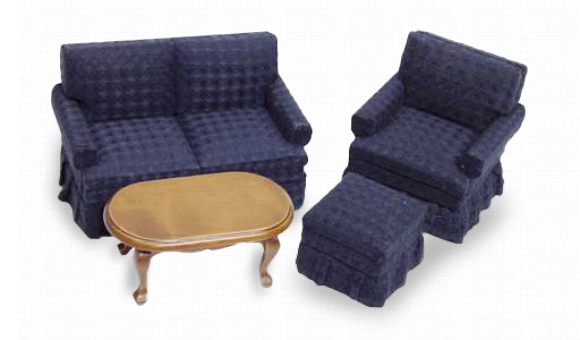The walls of the dollhouse should be sealed with a wood sealer or a flat white latex paint. When the wood is sealed, the wallpaper paste does not soak into the wood. Paint gives a better finish on which to apply both tape wiring and wallpaper, as well as provides a better color background for your miniature dollhouse wallpaper.
If you're wondering how to wallpaper and paint a dollhouse, read on. The first rule for wallpapering a dollhouse or room box is to choose a wallpaper design that is in scale with the project, no matter the scale. Your local miniature shop has miniature wallpaper which follows these scales. There are also some mini prints in regular wallpaper that will work for miniature. Be sure that you buy enough wallpaper for the project at one time. Dye lots change, and you may not be able to match the paper later. Always allow for mistakes and accidents. They happen!
Most miniature wallpaper comes either 11 1/2" x 18" or 12" x 18" sheets. For most dollhouses and room boxes, you will need one sheet of wallpaper for each wall. If you paper the door walls to match the corresponding rooms, you will need three sheets per room for a back opening house, and four sheets per room for a front opening house. When I paper the door wall section to match each corresponding room, I cover the seams with stained or painted 1/2" x 1-1/16" flat strip wood. The flat strip wood doesn't interfere with closing the door wall. Using one sheet per wall will also eliminate seams. On a small room, you might be able to get by with two sheets of paper. To be sure, check your measurements.
Of course, if you want to be frugal, or end up lacking enough paper, you can piece the wallpaper. This is particularly effective on a back wall or a wall with several windows and doors. Be sure you match the design, because you don't want it to look like patched pants! Start by using full-length pieces from ceiling to floor between the windows and doors. Then piece together with small sections above and below the windows and above the doors. As you apply the wallpaper, try to match the pattern. If you do have to piece the wallpaper, try to do it on a wall that is not in clear view. If the paper is carefully matched, most of the time you can not tell it has been pieced.
The ideal way to wallpaper a dollhouse is to use one piece of paper. This allows you to paper over the windows and doors, and also eliminates seams.
I use a paper cutter to cut my wallpaper. A paper cutter provides a good straight edge, and I can line the wallpaper up with the guidelines on the paper cutter. If you do not have a paper cutter, you can use a cutting board, a metal square or metal ruler with cork on the back, and an X-Acto knife or utility knife. You may also carefully measure and mark the back of the paper with line and then cut it with scissors.
Dry Wallpaper
The following steps involve the use of DRY wallpaper. Before applying wallpaper to the walls:
- Make sure all the walls have been sealed with either a wood sealer or a coat of white flat latex paint. Remember there is an up and down to the wallpaper design. When you cut, be sure that all the wallpaper sheets are going the same way. We have all cut a piece of wallpaper upside down, and consequently have run out of wallpaper.
- Measure the height and width of the wall to be papered.
To measure the wallpaper:- I like to place my paper even along the floor edge of the wall, and then crease it with your fingernail along the ceiling edge in order to get the height of the paper. Then check it with the measurement of the wall. On many occasions, I find that the wall measurement is not the same all the way across the wall. Remember that 1/16 or 1/32 of an inch can make a big difference in a dollhouse. Now you are ready to apply the paper to the walls. After trying many different types of paste, I prefer Mini Graphics Wallpaper Mucilage from the jar.
- Lay the piece of wallpaper on a hard washable surface. After a couple of hours, the paper should be dry and brittle over the windows and doors. Take an X-Acto knife or utility knife, and cut around the openings for the windows and doors. Remove the paper over the openings. Now you are ready to apply the interior trim. (See the Trim section.)
Ceilings
Paint the ceiling before the sidewalls. Many people paint the ceilings of the dollhouse rooms with white or off-white semi-gloss or flat paint. Semi-gloss tends to reflect the light in the room, while the flat finish seems to absorb the light. Choosing the right interior paint for your dollhouse is particularly important if the house is wired, as you will have better light in the room using semi-gloss paint. The interior of your dollhouse will take at least two coats of paint.
Wallpaper
Instead of painting the ceilings, I prefer to apply regular white or cream ceiling wallpaper. This should be done after wiring and before papering the sidewalls.
Paint the ceiling using a white paint with a flat finish first to seal the wood.
Stucco
You may also cover the ceilings with a textured material or stucco finish. I prefer pre-mixed Spackle, mixed with latex paint to the consistency of whipped cream. The color of the latex paint is determined by the color you want for the ceiling. If the color does not come out exactly to your liking, you may paint the ceiling after it dries. Apply the Spackle mixture with a stencil brush in the stipple method.
You can use this method on the interior walls, as well as the outside of the house. The amount and thickness you use on the interior walls depends on the resulting finish that you want. For the outside of your dollhouse, with a paint spatula or knife, apply a thicker coat for a different texture. Ice the finish onto the house like you would ice a cake, or stipple it with a brush.



